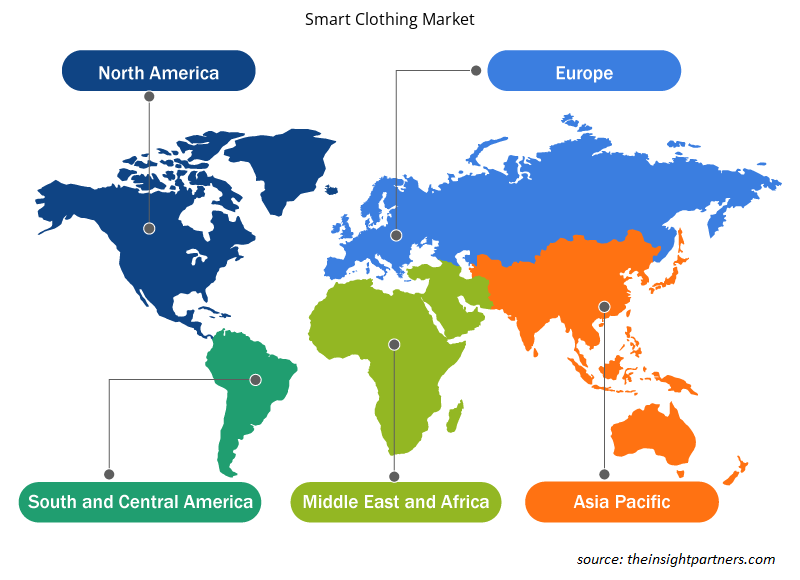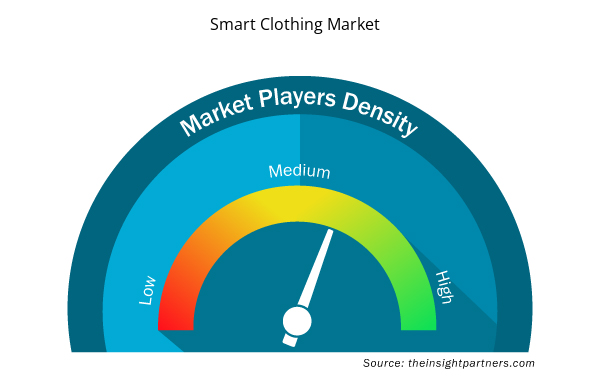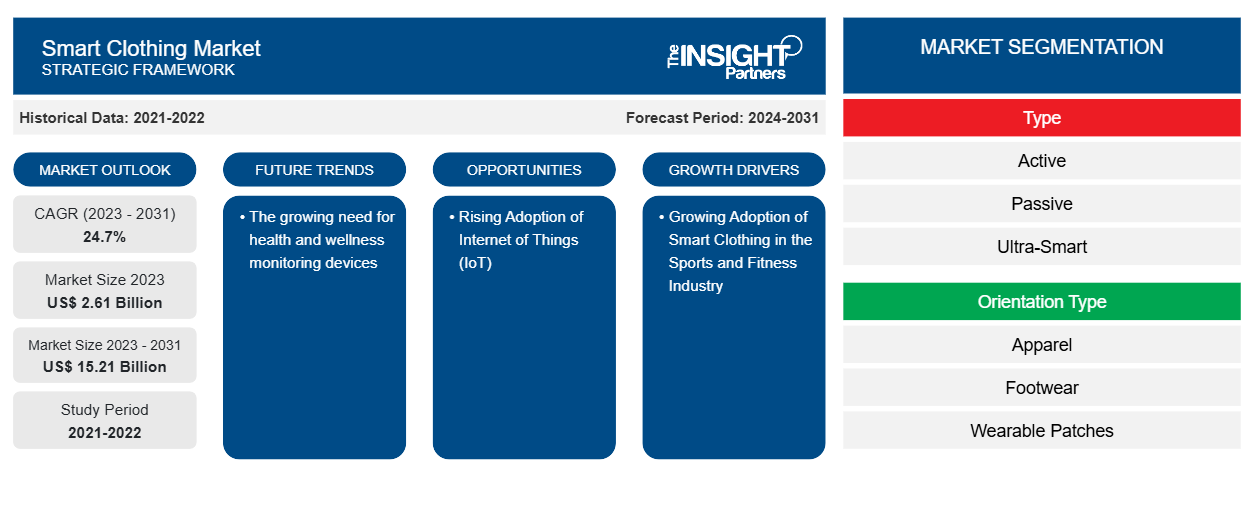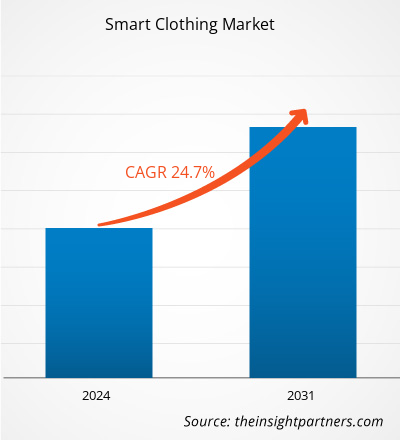Der Markt für Smart Clothing soll von 2,61 Milliarden US-Dollar im Jahr 2023 auf 15,21 Milliarden US-Dollar im Jahr 2031 anwachsen. Der Markt soll zwischen 2023 und 2031 eine durchschnittliche jährliche Wachstumsrate (CAGR) von 24,7 % verzeichnen. Der wachsende Bedarf an Geräten zur Überwachung von Gesundheit und Wohlbefinden dürfte ein wichtiger Trend auf dem Markt für Smart Clothing bleiben.
Marktanalyse für intelligente Kleidung
Der Markt für intelligente Kleidung wächst rasant, da intelligente Kleidung in der Sport- und Fitnessbranche immer beliebter wird und Sensoren zur Überwachung körperlicher Aktivitäten immer häufiger zum Einsatz kommen. Der Markt wächst stetig, angetrieben durch die zunehmende Verbreitung tragbarer Geräte. Darüber hinaus bietet die zunehmende Verbreitung des Internet der Dinge (IoT) lukrative Möglichkeiten für Marktwachstum.
Marktübersicht für intelligente Kleidung
Intelligente Kleidung integriert Elektronik in Kleidungsstücke, um deren Nutzen und Konnektivität zu verbessern. Diese Kleidungsstücke können biometrische Daten erfassen, Aktivitätsniveaus messen, die Temperatur regulieren und sogar haptisches Feedback geben. Der Markt für intelligente Kleidung bietet revolutionäre Kleidungsstücke mit eingebetteten Sensoren und Technologien, die die Alltagskleidung revolutionieren. Diese Kleidungsstücke verbessern das Gesundheits- und Lifestyle-Management, einschließlich Fitness-Tracking und biometrischer Überwachung. Sie liefern Echtzeitdaten, sodass Benutzer fundierte Entscheidungen bezüglich ihrer Gesundheit treffen können. Die Verwendung intelligenter Textilien auf eine Art und Weise erhöht nicht nur den Komfort, sondern fördert auch einen proaktiven Umgang mit der Gesundheit, was die Nachfrage bei den Verbrauchern erhöht und so den Markt antreibt.
Passen Sie diesen Bericht Ihren Anforderungen an
Sie erhalten kostenlose Anpassungen an jedem Bericht, einschließlich Teilen dieses Berichts oder einer Analyse auf Länderebene, eines Excel-Datenpakets sowie tolle Angebote und Rabatte für Start-ups und Universitäten.
- Holen Sie sich die wichtigsten Markttrends aus diesem Bericht.Dieses KOSTENLOSE Beispiel umfasst eine Datenanalyse von Markttrends bis hin zu Schätzungen und Prognosen.
Treiber und Chancen auf dem Smart Clothing-Markt
Die zunehmende Verbreitung intelligenter Kleidung in der Sport- und Fitnessbranche treibt den Markt an
Intelligente Kleidung hat in der Sport- und Fitnessbranche enormes Potenzial. Sportler und Fitnessbegeisterte nutzen intelligente Kleidung aufgrund ihrer Vorteile, wie der Echtzeitüberwachung physiologischer Daten wie Sauerstoffsättigung, Muskelaktivität, Herzfrequenz und Bewegungsmuster. Diese Daten sind nützlich, um Trainingsprogramme zu verfeinern, Verletzungsrisiken zu reduzieren und die Gesamtleistung zu verbessern. Darüber hinaus liefert intelligente Ausrüstung Feedback zu Haltung, Technik und Form, sodass Sportler Änderungen vornehmen und ihre Trainingsroutinen verbessern können. Die Integration intelligenter Kleidung mit tragbaren Geräten und mobilen Apps hilft Benutzern, ein ganzheitliches Fitness-Ökosystem zu schaffen, das Benutzern, die ihre Gesundheitsziele verbessern möchten, individuelle Informationen und Empfehlungen bietet.
Steigende Verbreitung des Internets der Dinge (IoT) – eine Chance auf dem Markt für intelligente Kleidung
Das Wachstum des IoT ermöglicht die nahtlose Integration von intelligenten Kleidungsstücken mit Smartphones und Smartwatches. Diese Konnektivität verbessert das Benutzererlebnis und ermöglicht neue Funktionen, was voraussichtlich Marktchancen schaffen wird. Die Verbreitung des IoT macht intelligente Kleidung zu einem immer wichtigeren Teil des vernetzten Ökosystems und bietet den Benutzern beispiellosen Komfort und Abwechslung in ihrem täglichen Leben. Darüber hinaus ermutigt die wachsende Nachfrage nach intelligenter Kleidung die Hersteller, technologisch fortschrittliche Lösungen zu entwickeln, um die Anforderungen der Verbraucher zu erfüllen. So haben Forscher der University of Waterloo im April 2023 ein bahnbrechendes „intelligentes Gewebe“ aus Polymer -Nanokompositfasern entwickelt , in die Edelstahldrähte eingebettet sind. Dieses Gewebe reagiert besonders auf Wärme und Elektrizität, wobei sich die eingebetteten Drähte bei Erwärmung zusammenziehen und ihre Form verändern.
Segmentierungsanalyse des Marktberichts für intelligente Kleidung
Wichtige Segmente, die zur Ableitung der Marktanalyse für intelligente Kleidung beigetragen haben, sind Typ, Ausrichtungstyp, Konnektivität und Endbenutzer.
- Basierend auf dem Typ ist der Markt für intelligente Kleidung in aktive, passive und ultra-intelligente Kleidung unterteilt. Das aktive Segment hatte im Jahr 2023 einen größeren Marktanteil.
- In Bezug auf die Ausrichtung ist der Markt in Bekleidung, Schuhe, tragbare Patches und andere unterteilt. Das Bekleidungssegment hatte im Jahr 2023 einen größeren Marktanteil.
- Auf der Grundlage der Konnektivität ist der Markt für intelligente Kleidung in Wi-Fi, Bluetooth, GPS und RFID unterteilt. Das GPS-Segment hatte im Jahr 2023 einen größeren Marktanteil.
- In Bezug auf den Endverbraucher wird der Markt in die Kategorien Gesundheitswesen, Mode und Lifestyle, Sport und Fitness, Militär und Sonstiges unterteilt. Das Segment Sport und Fitness hatte im Jahr 2023 einen größeren Marktanteil.
Smart Clothing Marktanteilsanalyse nach Geografie
Der geografische Umfang des Marktberichts für intelligente Kleidung ist hauptsächlich in fünf Regionen unterteilt: Nordamerika, Asien-Pazifik, Europa, Naher Osten und Afrika sowie Südamerika/Süd- und Mittelamerika.
In Bezug auf den Umsatz hatte Nordamerika den größten Marktanteil im Bereich Smart Clothing, was auf die positive Regierungsinitiative zur Förderung der Smart-Clothing-Technologie zurückzuführen ist. So investierte die US-Regierung im September 2023 22 Millionen US-Dollar, um die Initiative „Smart E-Pants“ zur Weiterentwicklung der Technologie für intelligente Überwachungskleidung zu fördern. Die Regierung plant, tragbare Kleidungsstücke zu entwickeln, die die Geolokalisierung verfolgen, Audio/Video aufzeichnen und physiologische Daten für Militärpersonal und Geheimdienste überwachen. Dies erhöht die Situationswahrnehmung und Datenerfassung in gefährlichen Umgebungen.
Regionale Einblicke in den Markt für intelligente Kleidung
Die regionalen Trends und Faktoren, die den Smart Clothing-Markt im Prognosezeitraum beeinflussen, wurden von den Analysten von Insight Partners ausführlich erläutert. In diesem Abschnitt werden auch die Marktsegmente und die Geografie des Smart Clothing-Marktes in Nordamerika, Europa, im asiatisch-pazifischen Raum, im Nahen Osten und Afrika sowie in Süd- und Mittelamerika erörtert.

- Erhalten Sie regionale Daten zum Smart Clothing-Markt
Umfang des Marktberichts für intelligente Kleidung
| Berichtsattribut | Details |
|---|---|
| Marktgröße im Jahr 2023 | 2,61 Milliarden US-Dollar |
| Marktgröße bis 2031 | 15,21 Milliarden US-Dollar |
| Globale CAGR (2023 - 2031) | 24,7 % |
| Historische Daten | 2021-2022 |
| Prognosezeitraum | 2024–2031 |
| Abgedeckte Segmente | Nach Typ
|
| Abgedeckte Regionen und Länder | Nordamerika
|
| Marktführer und wichtige Unternehmensprofile |
|
Dichte der Marktteilnehmer für Smart Clothing: Die Auswirkungen auf die Geschäftsdynamik verstehen
Der Markt für Smart Clothing wächst rasant, angetrieben durch die steigende Nachfrage der Endnutzer aufgrund von Faktoren wie sich entwickelnden Verbraucherpräferenzen, technologischen Fortschritten und einem größeren Bewusstsein für die Vorteile des Produkts. Mit steigender Nachfrage erweitern Unternehmen ihr Angebot, entwickeln Innovationen, um die Bedürfnisse der Verbraucher zu erfüllen, und nutzen neue Trends, was das Marktwachstum weiter ankurbelt.
Die Marktteilnehmerdichte bezieht sich auf die Verteilung von Firmen oder Unternehmen, die in einem bestimmten Markt oder einer bestimmten Branche tätig sind. Sie gibt an, wie viele Wettbewerber (Marktteilnehmer) in einem bestimmten Marktraum im Verhältnis zu seiner Größe oder seinem gesamten Marktwert präsent sind.
Die wichtigsten auf dem Smart-Clothing-Markt tätigen Unternehmen sind:
- AiQ Smart Clothing Inc.
- Carve Technologies Inc. (Hexoskin)
- NIEDLICHER SCHALTKREIS
- Applycon, sro
- Jabil Inc.
- Myontec GmbH
Haftungsausschluss : Die oben aufgeführten Unternehmen sind nicht in einer bestimmten Reihenfolge aufgeführt.

- Überblick über die wichtigsten Akteure auf dem Smart Clothing-Markt
Neuigkeiten und aktuelle Entwicklungen zum Smart-Clothing-Markt
Der Markt für Smart Clothing wird durch die Erhebung qualitativer und quantitativer Daten nach Primär- und Sekundärforschung bewertet, die wichtige Unternehmensveröffentlichungen, Verbandsdaten und Datenbanken umfasst. Im Folgenden finden Sie eine Liste der Entwicklungen auf dem Markt für Smart Clothing und Strategien:
- Im April 2023 arbeitete H & M Hennes & Mauritz GBC AB mit LanzaTech zusammen, um seinen Kunden eine Capsule-Kollektion aus CarbonSmart-Polyester anzubieten, einem bahnbrechenden Material, das wiederverwendete Kohlenstoffemissionen nutzt. Diese Partnerschaft ermöglicht es H&M Move, innovative Materialien zu erforschen und seinen Teil dazu beizutragen, in Zukunft intelligente und nachhaltigere Sportbekleidung zu schaffen. (Quelle: H & M Hennes & Mauritz GBC AB, Pressemitteilung, 2023)
Marktbericht zu intelligenter Kleidung – Umfang und Ergebnisse
Der Bericht „Marktgröße und Prognose für Smart Clothing (2021–2031)“ bietet eine detaillierte Analyse des Marktes, die die folgenden Bereiche abdeckt:
- Marktgröße und Prognose auf globaler, regionaler und Länderebene für alle wichtigen Marktsegmente, die im Rahmen des Projekts abgedeckt sind
- Marktdynamik wie Treiber, Beschränkungen und wichtige Chancen
- Wichtige Zukunftstrends
- Detaillierte PEST/Porters Five Forces- und SWOT-Analyse
- Globale und regionale Marktanalyse mit wichtigen Markttrends, wichtigen Akteuren, Vorschriften und aktuellen Marktentwicklungen
- Branchenlandschaft und Wettbewerbsanalyse, einschließlich Marktkonzentration, Heatmap-Analyse, prominenten Akteuren und aktuellen Entwicklungen
- Detaillierte Firmenprofile
- Historische Analyse (2 Jahre), Basisjahr, Prognose (7 Jahre) mit CAGR
- PEST- und SWOT-Analyse
- Marktgröße Wert/Volumen – Global, Regional, Land
- Branche und Wettbewerbsumfeld
- Excel-Datensatz


- Medical Audiometer Devices Market
- Medical Enzyme Technology Market
- Water Pipeline Leak Detection System Market
- Mobile Phone Insurance Market
- Space Situational Awareness (SSA) Market
- Clinical Trial Supplies Market
- Digital Pathology Market
- Quantitative Structure-Activity Relationship (QSAR) Market
- Batter and Breader Premixes Market
- Smart Water Metering Market

Report Coverage
Revenue forecast, Company Analysis, Industry landscape, Growth factors, and Trends

Segment Covered
This text is related
to segments covered.

Regional Scope
North America, Europe, Asia Pacific, Middle East & Africa, South & Central America

Country Scope
This text is related
to country scope.
Häufig gestellte Fragen
The incremental growth expected to be recorded for the global smart clothing market during the forecast period is US$ 12.60 billion.
The global smart clothing market is expected to reach US$ 15.21 billion by 2031.
The key players holding majority shares in the global smart clothing market are AiQ Smart Clothing Inc., Carve Technologies Inc. (Hexoskin), CUTECIRCUIT, Applycon, s. r. o., and Jabil Inc.
The growing need for health and wellness monitoring devices to play a significant role in the global smart clothing market in the coming years.
The growing adoption of smart clothing in the sports and fitness industry and the increasing adoption of sensors for monitoring bodily activities are the major factors that propel the global smart clothing market.
The global smart clothing market was estimated to be US$ 2.61 billion in 2023 and is expected to grow at a CAGR of 24.7% during the forecast period 2023 - 2031.
Trends and growth analysis reports related to Electronics and Semiconductor : READ MORE..
The Insight Partners performs research in 4 major stages: Data Collection & Secondary Research, Primary Research, Data Analysis and Data Triangulation & Final Review.
- Data Collection and Secondary Research:
As a market research and consulting firm operating from a decade, we have published and advised several client across the globe. First step for any study will start with an assessment of currently available data and insights from existing reports. Further, historical and current market information is collected from Investor Presentations, Annual Reports, SEC Filings, etc., and other information related to company’s performance and market positioning are gathered from Paid Databases (Factiva, Hoovers, and Reuters) and various other publications available in public domain.
Several associations trade associates, technical forums, institutes, societies and organization are accessed to gain technical as well as market related insights through their publications such as research papers, blogs and press releases related to the studies are referred to get cues about the market. Further, white papers, journals, magazines, and other news articles published in last 3 years are scrutinized and analyzed to understand the current market trends.
- Primary Research:
The primarily interview analysis comprise of data obtained from industry participants interview and answers to survey questions gathered by in-house primary team.
For primary research, interviews are conducted with industry experts/CEOs/Marketing Managers/VPs/Subject Matter Experts from both demand and supply side to get a 360-degree view of the market. The primary team conducts several interviews based on the complexity of the markets to understand the various market trends and dynamics which makes research more credible and precise.
A typical research interview fulfils the following functions:
- Provides first-hand information on the market size, market trends, growth trends, competitive landscape, and outlook
- Validates and strengthens in-house secondary research findings
- Develops the analysis team’s expertise and market understanding
Primary research involves email interactions and telephone interviews for each market, category, segment, and sub-segment across geographies. The participants who typically take part in such a process include, but are not limited to:
- Industry participants: VPs, business development managers, market intelligence managers and national sales managers
- Outside experts: Valuation experts, research analysts and key opinion leaders specializing in the electronics and semiconductor industry.
Below is the breakup of our primary respondents by company, designation, and region:

Once we receive the confirmation from primary research sources or primary respondents, we finalize the base year market estimation and forecast the data as per the macroeconomic and microeconomic factors assessed during data collection.
- Data Analysis:
Once data is validated through both secondary as well as primary respondents, we finalize the market estimations by hypothesis formulation and factor analysis at regional and country level.
- Macro-Economic Factor Analysis:
We analyse macroeconomic indicators such the gross domestic product (GDP), increase in the demand for goods and services across industries, technological advancement, regional economic growth, governmental policies, the influence of COVID-19, PEST analysis, and other aspects. This analysis aids in setting benchmarks for various nations/regions and approximating market splits. Additionally, the general trend of the aforementioned components aid in determining the market's development possibilities.
- Country Level Data:
Various factors that are especially aligned to the country are taken into account to determine the market size for a certain area and country, including the presence of vendors, such as headquarters and offices, the country's GDP, demand patterns, and industry growth. To comprehend the market dynamics for the nation, a number of growth variables, inhibitors, application areas, and current market trends are researched. The aforementioned elements aid in determining the country's overall market's growth potential.
- Company Profile:
The “Table of Contents” is formulated by listing and analyzing more than 25 - 30 companies operating in the market ecosystem across geographies. However, we profile only 10 companies as a standard practice in our syndicate reports. These 10 companies comprise leading, emerging, and regional players. Nonetheless, our analysis is not restricted to the 10 listed companies, we also analyze other companies present in the market to develop a holistic view and understand the prevailing trends. The “Company Profiles” section in the report covers key facts, business description, products & services, financial information, SWOT analysis, and key developments. The financial information presented is extracted from the annual reports and official documents of the publicly listed companies. Upon collecting the information for the sections of respective companies, we verify them via various primary sources and then compile the data in respective company profiles. The company level information helps us in deriving the base number as well as in forecasting the market size.
- Developing Base Number:
Aggregation of sales statistics (2020-2022) and macro-economic factor, and other secondary and primary research insights are utilized to arrive at base number and related market shares for 2022. The data gaps are identified in this step and relevant market data is analyzed, collected from paid primary interviews or databases. On finalizing the base year market size, forecasts are developed on the basis of macro-economic, industry and market growth factors and company level analysis.
- Data Triangulation and Final Review:
The market findings and base year market size calculations are validated from supply as well as demand side. Demand side validations are based on macro-economic factor analysis and benchmarks for respective regions and countries. In case of supply side validations, revenues of major companies are estimated (in case not available) based on industry benchmark, approximate number of employees, product portfolio, and primary interviews revenues are gathered. Further revenue from target product/service segment is assessed to avoid overshooting of market statistics. In case of heavy deviations between supply and demand side values, all thes steps are repeated to achieve synchronization.
We follow an iterative model, wherein we share our research findings with Subject Matter Experts (SME’s) and Key Opinion Leaders (KOLs) until consensus view of the market is not formulated – this model negates any drastic deviation in the opinions of experts. Only validated and universally acceptable research findings are quoted in our reports.
We have important check points that we use to validate our research findings – which we call – data triangulation, where we validate the information, we generate from secondary sources with primary interviews and then we re-validate with our internal data bases and Subject matter experts. This comprehensive model enables us to deliver high quality, reliable data in shortest possible time.


 Holen Sie sich ein kostenloses Muster für diesen Bericht
Holen Sie sich ein kostenloses Muster für diesen Bericht